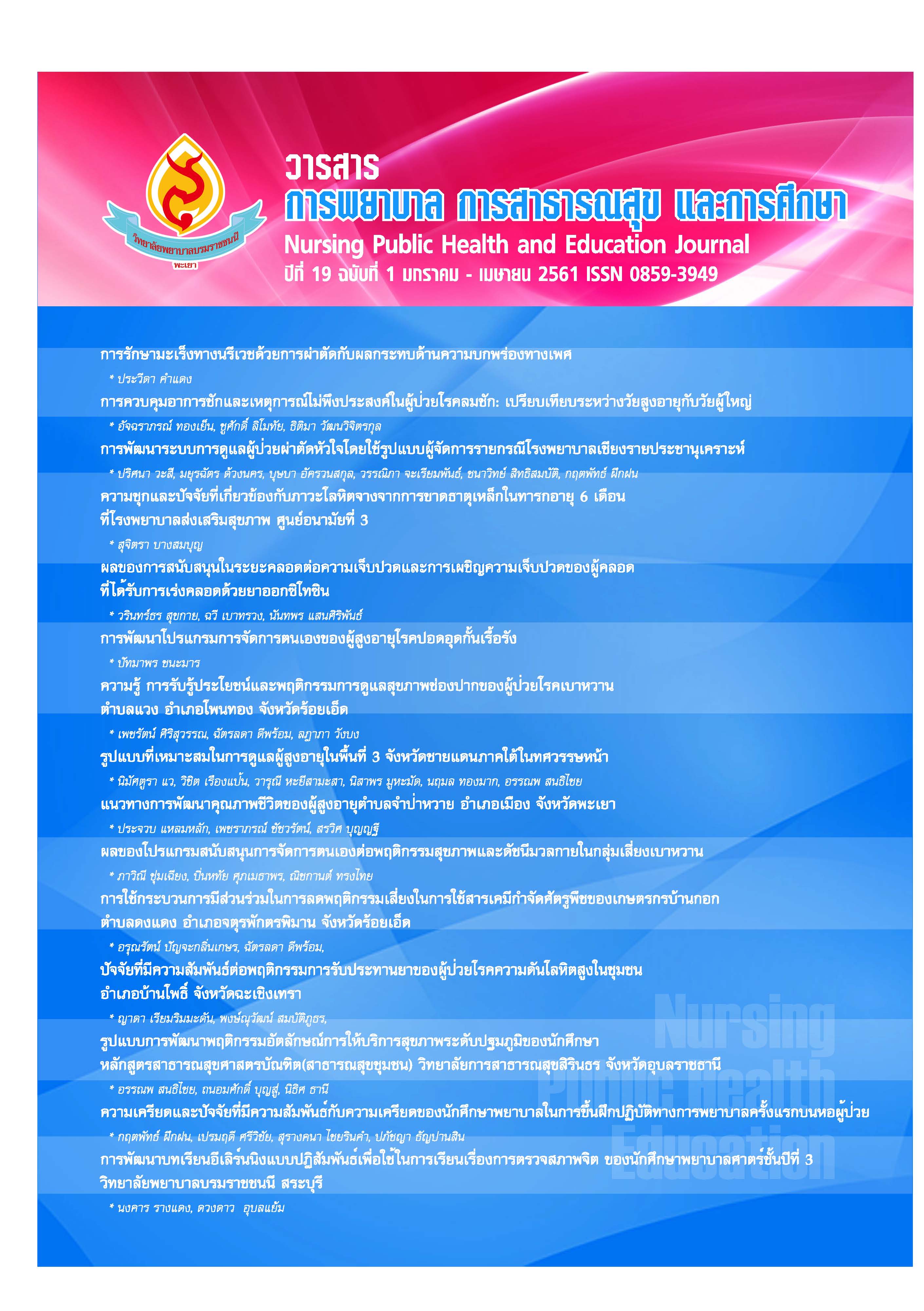การพัฒนาโปรแกรมการจัดการตนเองในผู้สูงอายุโรคปอดอุดกั้นเรื้อรัง จังหวัดมหาสารคาม
Keywords:
การจัดการตนเอง, โรคปอดอุดกั้นเรื้อรัง, โปรแกรมการจัดการตนเอง, ผู้สูงอายุ, Self-management, Chronic obstructive pulmonary disease, Self- management program, The older patientsAbstract
การวิจัยและพัฒนานี้มีวัตถุประสงค์ เพื่อศึกษาปัจจัยเชิงสาเหตุที่มีผลต่อพฤติกรรมการจัดการตนเองของผู้สูงอายุโรคปอดอุดกั้นเรื้อรัง เพื่อสร้างโปรแกรมการจัดการตนเองของผู้สูงอายุโรคปอดอุดกั้นเรื้อรังเพื่อทดลองใช้และประเมินผลโปรแกรมการจัดการตนเองของผู้สูงอายุโรคปอดอุดกั้นเรื้อรัง วิธีดำเนินการวิจัยแบ่งเป็น 3 ระยะ คือ 1) ศึกษาปัจจัยเชิงสาเหตุที่ส่งผลทางตรงและทางอ้อมต่อพฤติกรรมการจัดการตนเองของผู้สูงอายุโรคปอด อุดกั้นเรื้อรัง กลุ่มตัวอย่างเป็นผู้สูงอายุโรคปอดอุดกั้นเรื้อรัง จังหวัดมหาสารคาม จำนวน 325 คน สุ่มตัวอย่างโดยวิธีกำหนดสัดส่วน และการสุ่มอย่างง่าย เครื่องมือการวิจัย เก็บข้อมูลโดยใช้แบบสอบถาม วิเคราะห์ข้อมูลโดยใช้สถิติวิเคราะห์การถดถอยพหุคูณเชิงเส้นตรง และการวิเคราะห์สมการเชิงโครงสร้างโดยใช้โปรแกรมลิสเรล เพื่ออธิบายอิทธิพลเส้นทาง หรือปัจจัยเชิงสาเหตุที่ส่งผลทั้งโดยตรงและโดยอ้อมต่อพฤติกรรมการจัดการตนเอง จากการตรวจสอบแบบจำลองกับข้อมูลเชิงประจักษ์ 2) สร้างโปรแกรมการจัดการตนเองของผู้สูงอายุโรคปอดอุดกั้นเรื้อรัง โดยนำตัวแปรอิสระที่พบว่าส่งผลต่อพฤติกรรมการดูแลตนเองอย่างมีนัยสำคัญทางสถิติที่ระดับ .05ให้ผู้มีส่วนเกี่ยวข้องจำนวน 20 คน วิพากษ์ โดยการประชุมกลุ่มย่อย และการระดมสมองแล้วให้ผู้เชี่ยวชาญประเมินความเหมาะสมของโปรแกรมการจัดการตนเองของผู้สูงอายุโรคปอดอุดกั้นเรื้อรัง 3) ทดลองใช้และประเมินผลโปรแกรมการจัดการตนเองของผู้สูงอายุโรคปอดอุดกั้นเรื้อรังจังหวัดมหาสารคาม กลุ่มทดลองคือผู้สูงอายุโรคปอดอุดกั้นเรื้อรังในโรงพยาบาลวาปีปทุม จำนวน 20 คน เปรียบเทียบพฤติกรรมการจัดการตนเองระหว่างก่อนและหลังการใช้โปรแกรมด้วยการวิเคราะห์ความแปรปรวนหลายตัวแปรตามแบบวัดซ้ำ ผลการวิจัย 1. แบบจำลองความสัมพันธ์เชิงสาเหตุ มีความกลมกลืนกับข้อมูลเชิงประจักษ์ โดยตัวแปรเชิงสาเหตุที่ส่งผลโดยตรงและโดยอ้อมต่อพฤติกรรมการจัดการตนเองของผู้สูงอายุโรคปอดอุดกั้นเรื้อรังจังหวัดมหาสารคาม มี 9 ตัวแปร เรียงลำดับค่าสัมประสิทธิ์อิทธิพลจากมากไปหาน้อย คือ ปัจจัยด้านการมีส่วนร่วม รองลงมา ได้แก่ ด้านแรงจูงใจ ความเชื่อด้านสุขภาพ ด้านภาวะซึมเศร้า ด้านความรู้ ด้านแรงสนับสนุนทางสังคม ด้านการรับรู้สมรรถนะแห่งตน ด้านแรงสนับสนุนของครอบครัว และปัจจัยที่มีอิทธิพลต่ำที่สุดคือ ด้านเจตคติต่อการดูแลตนเอง2. โปรแกรมการจัดการตนเองของผู้สูงอายุโรคปอดอุดกั้นเรื้อรัง ประกอบ 4 ขั้นตอน และ 8 กิจกรรม 3. โปรแกรมการจัดการตนเองของผู้สูงอายุโรคปอดอุดกั้นเรื้อรัง จังหวัดมหาสารคามที่ผู้วิจัยสร้างขึ้นมีผลทำให้พฤติกรรมการจัดการตนเองของผู้สูงอายุโรคปอดอุดกั้นเรื้อรังเพิ่มขึ้นมากกว่าก่อนการทดลอง อย่างมีนัยสำคัญทางสถิติที่ระดับ .05 ทั้งการทดสอบโดยรวม และการทดสอบทีละตัวแปร รวมทั้งสมรรถนะทางกายและคุณภาพชีวิตดีขึ้นกว่าก่อนการใช้โปรแกรม อย่างมีนัยสำคัญทางสถิติ
The Development of Self- management Program in the older patients with Chronic obstructive pulmonary disease
The purposes of the research were to identify causal factors affecting self-management behavior in the older patients with Chronic obstructive pulmonary disease , to design a self-management model for the older patients withChronic obstructive pulmonary disease, and to implement and evaluation the model with the target patients. The research framework consisted of three phases: Phase 1: The quantitative research was employed for the study, which focused on analyzing the causal factors affecting directly and indirectly self-management behavior of the older patients withChronic obstructive pulmonary disease. The data were collected from three hundred and twenty five older patients with Chronicobstructive pulmonary disease by questionnaires. The samples were selected by the quota random sampling andsimple random sampling methods. The data were analyzed by Multiple Linear Regression Analysis and Structural Equation Model: SEM. LISREL was employed for Path Analysis. Phase 2: The study focused on designing a self-management model for the older patients withChronic Obstructive Pulmonary Disease. The model was designed based on the significant relation of the independent variables and self-management behavior of the older patients. The model was assessed by twenty experts through focus group and brainstorming methods. Phase 3: The research focused on implementing and evaluating the model with twenty target older patients. Their self-management behaviors before using the model was compare to the behavior after using the model. Multivariate Analysis of Variance: MANOVA (Repeated Measure) was employed for data analysis.Results of the research were as follows: 1.Regarding the relationships between the causal factors and the empirical data, the findings indicated that nine factors significantly affected the self-management behaviors of the older patients. The factors consisted of motivation support (= .51), participation (= .42), attitude (= .31), knowledge (= .29),depression (= .27), social support (= .27), Perceived self-efficacy (= .21),belief in health (= .10) and family support (= .09).2.The model included eleven key activities: 1 )Buddy giver2) nearest mind3) traininginchronic obstructive pulmonarydisease, 4) traininginpulmonary rehabilitationstretching exercises,5) medicine Education, 6) food trainingfor patients withCOPD7) telling past experiences 8) my guide. The findings indicated that the self-management behaviors of the patients after using the model improved greatly at the .05 level of the statistical significance in overall (Multivariate t=T) and each variable (Univariate Test).


